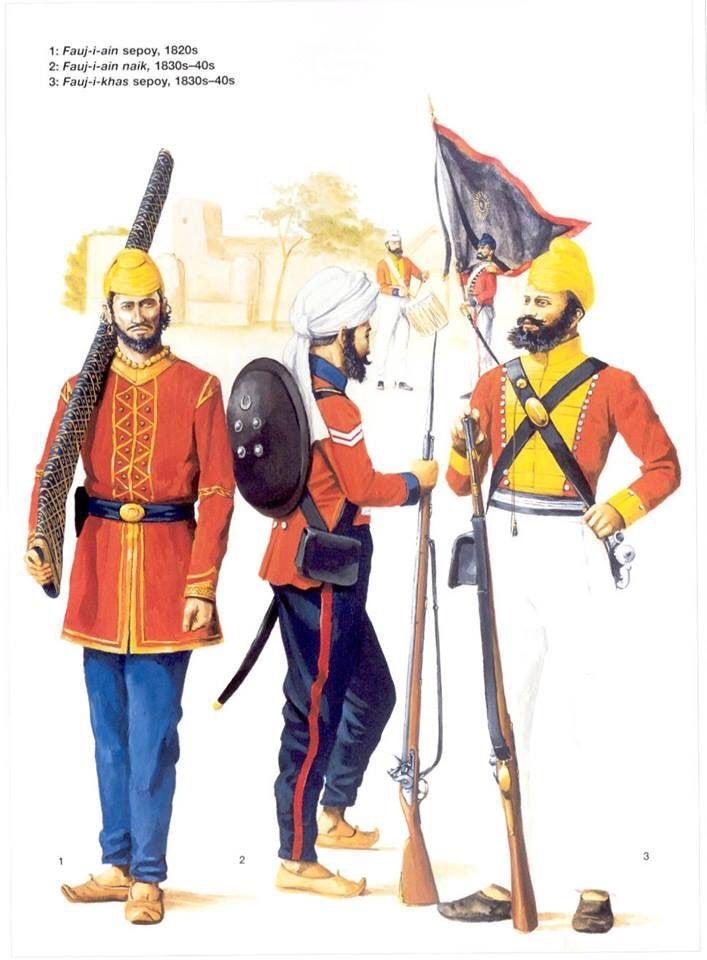Uniforms Of Sikh Khalsa Army:
Regular troops wore distinctive uniforms as prescribed for each force. Cavalrymen were dressed in red jackets (French grey for lancers), long blue trousers with a red stripe, and crimson turbans. Woollen jackets were used during winter. The regiments were armed with varying combinations of weapons sword/sabres and carbines and matchlocks or lances. Infantry was clad in scarlet jacket/coat, white trousers with black belts and pouches. Different regiments were distinguished by the colour of their headdress white, red, green or yellow. The Gurkhas had green jackets and black caps. Postins (furcoats), or padded jackets were used during winter.
Gunners wore white trousers and black waistcoats with crossbelts. Officers were not bound by rules of uniform. They used distinctive dress of bright coloured silks each picking his own as he saw fit. The ghorcharhas or the irregular cavalry had no uniform laid down for them; yet they turned out sharply, as testified by Baron Hugel, a Prussian noble, who visited Maharajah Ranjit Singh in 1836 and inspected a cavalry parade. "I never beheld," he wrote of a troop of ghorcharhas, "a finer nor a more remarkably striking body of men. Each one was dressed differently, and yet so much in the same fashion that they all looked in perfect keeping."
Army service was on a purely voluntary basis. There was no class composition on the basis of religion or nationality, nor was there a prescribed age limit for enrolment or retirement. Physical fitness and loyalty to the State were the essential conditions. However, the clannish basis of the misls in the FaujiBeqava'id ensured solidarity in the lower rungs of military administration. Similarly, bravery in the field and efficiency in the performance of duty were the only considerations for promotion and reward, which were also extended to the sons of those who died in action.
Regular troops wore distinctive uniforms as prescribed for each force. Cavalrymen were dressed in red jackets (French grey for lancers), long blue trousers with a red stripe, and crimson turbans. Woollen jackets were used during winter. The regiments were armed with varying combinations of weapons sword/sabres and carbines and matchlocks or lances. Infantry was clad in scarlet jacket/coat, white trousers with black belts and pouches. Different regiments were distinguished by the colour of their headdress white, red, green or yellow. The Gurkhas had green jackets and black caps. Postins (furcoats), or padded jackets were used during winter.
Gunners wore white trousers and black waistcoats with crossbelts. Officers were not bound by rules of uniform. They used distinctive dress of bright coloured silks each picking his own as he saw fit. The ghorcharhas or the irregular cavalry had no uniform laid down for them; yet they turned out sharply, as testified by Baron Hugel, a Prussian noble, who visited Maharajah Ranjit Singh in 1836 and inspected a cavalry parade. "I never beheld," he wrote of a troop of ghorcharhas, "a finer nor a more remarkably striking body of men. Each one was dressed differently, and yet so much in the same fashion that they all looked in perfect keeping."
Army service was on a purely voluntary basis. There was no class composition on the basis of religion or nationality, nor was there a prescribed age limit for enrolment or retirement. Physical fitness and loyalty to the State were the essential conditions. However, the clannish basis of the misls in the FaujiBeqava'id ensured solidarity in the lower rungs of military administration. Similarly, bravery in the field and efficiency in the performance of duty were the only considerations for promotion and reward, which were also extended to the sons of those who died in action.
Uniforms Of Sikh Khalsa Army:
Regular troops wore distinctive uniforms as prescribed for each force. Cavalrymen were dressed in red jackets (French grey for lancers), long blue trousers with a red stripe, and crimson turbans. Woollen jackets were used during winter. The regiments were armed with varying combinations of weapons sword/sabres and carbines and matchlocks or lances. Infantry was clad in scarlet jacket/coat, white trousers with black belts and pouches. Different regiments were distinguished by the colour of their headdress white, red, green or yellow. The Gurkhas had green jackets and black caps. Postins (furcoats), or padded jackets were used during winter.
Gunners wore white trousers and black waistcoats with crossbelts. Officers were not bound by rules of uniform. They used distinctive dress of bright coloured silks each picking his own as he saw fit. The ghorcharhas or the irregular cavalry had no uniform laid down for them; yet they turned out sharply, as testified by Baron Hugel, a Prussian noble, who visited Maharajah Ranjit Singh in 1836 and inspected a cavalry parade. "I never beheld," he wrote of a troop of ghorcharhas, "a finer nor a more remarkably striking body of men. Each one was dressed differently, and yet so much in the same fashion that they all looked in perfect keeping."
Army service was on a purely voluntary basis. There was no class composition on the basis of religion or nationality, nor was there a prescribed age limit for enrolment or retirement. Physical fitness and loyalty to the State were the essential conditions. However, the clannish basis of the misls in the FaujiBeqava'id ensured solidarity in the lower rungs of military administration. Similarly, bravery in the field and efficiency in the performance of duty were the only considerations for promotion and reward, which were also extended to the sons of those who died in action.
0 Comments
0 Shares
0 Reviews


